Ksapa joined a new workgroup whose object is the mainstreaming of sustainable consumption behavior. We kicked off the conversation with a presentation from Randi Kronthal-Sacco, researcher at the NYU Stern Center for Sustainable Business. Here, Ksapa shares key learnings from the Sustainable Share Index, its business implications and solutions to move the needle further toward sustainable consumption behavior.
With a second wave of the Covid-19 pandemic upon us, businesses and investors seem to be catching up to their responsibility in the economic recession and inequalities nexus. There is at least a growing recognition of the impeding risks, as well as the $12 trillion business opportunity tied to fulfilling the Sustainable Development Goals by 2030.
That said, corporate growth is generally indexed on selling more to the broadest base. With a projected 9 billion global population by 2050, that trend will likely not be overturned, particularly as the middle-class should expand to 3 billion by 2030, driven by emerging countries. Our current pandemic only enshrines an increasing awareness of the climate and socio-economic crises at hand. Already in 2019, 73% of consumers claimed they would change what they buy to cut their environmental footprint. Still, we approach consumption opportunities based on convenience, price and awareness. This apparent gap in aspirations may also be determined by product availability, with 26% of respondents seeking more ecological purchasing options. At the heart of this evolution, 40% Gen Z consumers consider sustainably-sourced ingredients as paramount, followed by 38% of Millennials and 34% among Baby-Boomers.
Key Learnings from the Sustainable Share Index
The Sustainable Share Index offers a large-scale study of US purchases based on IRI retail barcode data collected between 2013 and 2018. The analysis zeroed in on 36 consumer packaged goods categories (CPG), grossing 41% of overall CPG dollar volume. The goal was to assess the variation of marketing messages from categories with high and low sustainability-marketed share development. The main conclusion is that sustainably-marketed products grew 5.6 times faster than others. While sustainably-marketed products represented 16.6% of the total CPG market in 2018 (up from 14.3% in 2013), they took over a 50.1% share of market growth. Further insights cover the following:
- The growth of sustainably-marketed products proves greater than the overall growth of 33 of 36 analyzed product categories.
- Sustainably-marketed products enjoy a 39.5% premium compared to their conventionally-marketed counterparts and gained 5,3 percentage points between 2014 and 2018.
- In 4 of 5 focus categories, third-party certifications supportive of sustainability claims generate more impact than other sustainably-marketed products without.
- Sustainability-oriented messaging is often specific to a given product category, with claims to organic production generally making the most impact.
Sustainability-marketed products shares kept growing regardless of the impact of the Covid-19 global pandemic on the broader economy and supply chain. Indeed, with a 17% market share during the first half of 2020, sustainability-marketed products saw a 56% increase in dollar sales during the third week-end of March, as people rushed to stock on packaged goods. Meanwhile, more than 70% consumers estimated they had bought more or as many so-called eco-friendly products. Sustainably-marketing generally outperformed CPG growth, a trend sustained rather than overturned since… hinting that consumers generally adopted the sustainably-marketed products they sampled during lockdown.
Business Implications of the Sustainable Share Index
The Sustainable Share Index focuses on retail barcode data, to consider the effectiveness of marketing product sustainability. Delving into the sustainability of consumers’ behavior entails a broader consideration of the corresponding business strategy. The question then is to assess whether growth models rely solely on consumerism and at what socio-environmental cost? With that in mind, does the limited availability of natural resources affect company growth and does it actually offer better livelihoods across its supply chains? To that end, Ksapa outlines 3 key levers of sustainable consumption behavior – namely the purse, body and tribe.
1. The Purse
Regardless of our awakening to the impact of climate change on our daily lives, purchases are still determined by price first and foremost. Second is our perception of product efficacy, for which we as customers are often willing to spend more.
A Nielsen 2018 survey showed 49% of global respondents were inclined to pay higher-than-average prices for products with high-quality/safety standards, which they – rightly or not – tend to associate with sustainable practices. In fact, 46% of consumers prioritized safety and function notably by looking to sulfate, hormone and mineral-free claims, while 38% claimed they would pay more for sustainable materials and 30% for social responsibility commitments. Despite a price increase, the Indian market growth for so-called natural personal care products is twice as high as its counterparts, for example.
The Sustainable Share Index confirms the prevalence of this price/efficacy ratio, particularly in hygiene products, such as laundry care and sanitary napkins, where consumers appear to be less concerned about performance trade-offs. The study notably stresses how sustainability-marketed hygiene products perform best if combined with explicit efficacy claims. In fact, sanitary napkins and laundry care saw a 150% growth in the market share of sustainability-marketed products; a trend likely to be reinforced by contagion concerns linked to Covid-19.
2. The Body
This example of hygiene products is particularly interesting, as the industry has enjoyed a seemingly unrelenting growth. For instance, the average American family spends an annual 600 to 800 dollars on household cleaning products. Again, that trend only stands to grow given the current pandemic, regardless of the wealth of scientific literature on the negative impacts of chemicals on air and water quality, biodiversity or even food.
Grappling with the apparent contradiction of cleaning their homes with products negatively impacting their immediate environment, American consumers tend to prioritize non-toxic product claims above all else, with an average rating of 4.09 out of 5. While more and more consumers strive to align what they purchase to clean their body and home with their environmental convictions, negative messaging may induce psychological reactance. In fact, non-profit campaigns based on shock value mostly produced indifference or counterproductive behavior.
As a result, leaders of the personal care industry have tended to err on the side of caution, if they considered recalibrating their formula at all. More often than not, they have focused on catering to consumer habitual purchasing and the cost of pulling products from the aisle should their sustainability claims be found misleading.
3. The Tribe – Community Perception of Consumption Habits
That said, the rise of the sustainably and ethically-oriented Millennial or Gen Z consumer is bound to affect consumption habits – and corporate marketing in tow.
This growing contingent generally enjoys more disposable income, mobilizes for a greater variety of causes and relates to public and private institutions in a more pragmatic manner. Pinterest notably reported a 69% surge in user searches around sustainability, sustainable living becoming the most searched term and “sustainable living for beginners” queries up by 265%.
As they are generally digital native consumers, Millennials and Gen Z are also particularly prone to promoting the brands they appreciate, not just forgo those they see as contrary to their values. According to the 2020 Edelman Trust Barometer, 60% American consumers will indeed buy or boycott brands based on how they address racial equality in the wake of police violence and Black Lives Matter demonstrations.
The rise of the activist consumer has materialized on social media, were boycott abound, as do calls for advertisers to stop their spending on content considered objectionable. Businesses have adapted to this brand tribalism by overturning traditional marketing segmentation (primarily based on geography, demography and income), adding further insight into individual interests and vocations. For instance, subscription companies with targeted student seed programs tend to find 90% pay full price upon graduation. This also means consumption norms emerge within consumer tribes, so that only certain purchasing behaviors are deemed socially acceptable. Businesses have caught on and increasingly recruit brand ambassadors and influencers. A 2015 study showed that given the opportunity, 80% of consumers would tell friends and family about a company’s societal commitments and more than 70% would either donate or volunteer for a charity supported by a company they trust.
Solutions for Mainstreaming Sustainable Consumption Behavior
Given the far-reaching implications of the Sustainable Share Index, sustainable consumption behavior depends on our capacity to activate one or several of these 3 levers concomitantly.
1. Levelling the Playing Field Through Regulation
Addressing the price/efficacy ratio would entail ensuring socio-environmental claims no longer constitute a competitive edge. Leading businesses have in fact called on multilateral institutions to level the playing field via cross-cutting regulations, most recently with regards to the proposed European directive on mandatory Human Rights due diligence.
A likeminded approach, eco-labelling would legislate on third-party certification. Indeed, two-thirds of consumers in France, Germany, Italy, the Netherlands, Spain, Sweden, the UK and the US support carbon labelling on products. For the time being, only Denmark has made it compulsory and only for food sold in supermarkets at that. Companies would likely argue such a measure would create a market distortion, given a peer-reviewed and ISO-compliant lifecycle assessment of a food product generally costs between £10K and £20K per SKU.
2. Clarifying Content to Appeal to Consumers
Another issue with going the normative route is that product labelling must appeal to consumers and show they are good for them and good the planet. While one study found that food labels showcasing environmental information could improve the carbon footprint of an individual’s diet by as much 5%, consumers face a barrage of claims and labels. To name but one example, the Ecolabel Index tracks 457 ecolabels across 199 countries and 25 industries, with as many as 10 different logos for organic products globally.
When product packaging indeed sports these labels, few consumers are equipped to decipher them. Companies have lobbied to communicate their products’ carbon reduction potential using the metric system, but anyone would be hard pressed to identify just how a kilo of carbon affects their daily life. Meanwhile, inspired by Tesco’s “low-carbon orange juice”, scientists estimated it would take 32 years’ worth of daily purchases to save the same amount of carbon as 1 return flight from the UK to Spain. Without context, the best case scenario is that consumers infer corporate efforts to curb climate change, instead of being actually informed, in a way that allows them to compare products and purchase the soundest option for them.
3. Harnessing Digital Technologies for Collective Change
Because it addresses all 3 levers of sustainable consumption behavior, Ksapa described the importance of harnessing digital technologies to affect collective change in its Toward 2030 report. The food traceability market is expected to surge, thanks to blockchain and machine learning insights into how ingredients are actually sourced, process documented and values distilled across the organization. This affects marketing, as consumers preferentially turn to brands capable of offering enriched experiences beyond packaging, engaging with them via QR codes tied to content optimized for social sharing or visually packaged on dedicated websites.
With 12 million users, Yuka offers a prime example of how mobile applications push brands and manufacturers to better their products. Yuka’s algorithm uses 3 criteria to score food products, with 60 points for nutritional quality, 30 for the presence of additives and their level of risk and 10 for organic farming. An internal poll showed 83% of its users claiming they were buying less but higher quality products and 94% had stopped buying certain products because of their negative scores. Owing to the ensuing media storm, major retailor Intermarché committed to removing 142 additives from 900 of its recipes.
Other media may come into play, given their unique potential to engage the consumer more directly. Academic studies notably demonstrated the power of virtual reality to activate embodied cognition. For example, an ocean acidification simulation generated greater empathy than a similar video-only experience, while putting the consumers in the literal shoes of endangered species may increase their engagement with nature. Not only would the consumer tap into socio-environmental insights into the products they buy, they would do so faster and more dynamically.
Conclusion: Helping the Consumers Meet the Sustainable Challenge
According to the CDP, 90% of the consumer goods sector’s carbon footprint lies in its value chain, challenging raw material sourcing as leaving companies open to major product consumption risks. Buying sprees and supply chain disruption brought to bear by Covid-19 and lockdown measures show an opportunity for business to reconsider their growth models and broader organizations.
The coordinator of a newly-minted working group on sustainable consumption, Diane Osgood joins Ksapa in stressing that “consumers are increasingly opting for more sustainable lifestyles, so that the global demand for sustainable products is likely to keep growing. To remain relevant and #buildbackbetter, companies not only need to address this emerging trend, they must help expand it”. In other words, the time is ripe for companies to improve how they communicate sustainable product characteristics and engage shoppers accordingly. “Our working group plans on convening monthly to delve into the practicalities of doing just that”, she adds.
As a sustainability and corporate responsibility consultant, Margaux joined Ksapa with international experience in public, private and non-profit organizations. She had previously worked for the Deloitte and Quantis sustainability consultancies, lobbied for environmental research on behalf of the INRA and contributed to Total’s extra-financial reporting.
A Franco-American citizen, Margaux holds sustainability certifications from the IEMA and Centrale-Supélec on top of a Masters degree in History, Communications, Business and Internal Affairs.
She is fluent in French, English and Spanish.






